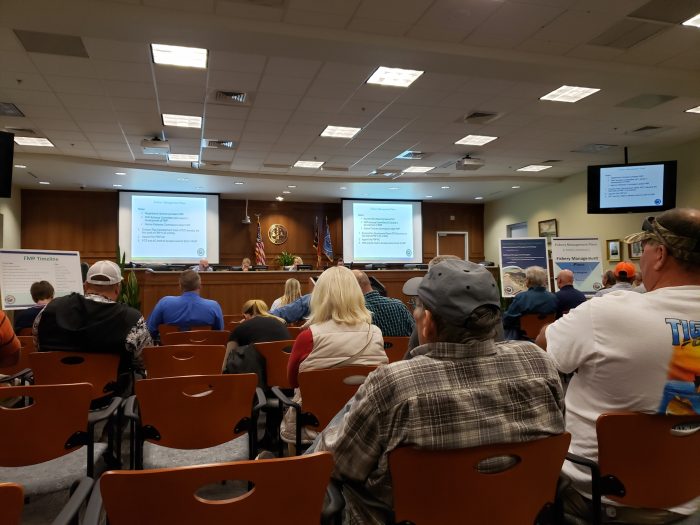
The N.C. Division of Marine Fisheries (DMF) collected public comments and feedback at a heated scoping meeting in Manteo on Tuesday night as part of their long-term process to create management strategies for the upcoming Amendment 3 to the Southern Flounder Fishery Management Plan.
On August 23, the North Carolina Marine Fisheries Commission (MFC) voted for the adoption of the Southern Flounder Fishery Management Plan Draft Amendment 2, which resulted in a proclamation that closed the commercial and recreational season for southern flounder on September 4.
The Southern Flounder Fishery Management Plan (FMP) stems from State law which mandates a minimum 52% reduction in flounder catches this year, (compared to 2017 numbers), and a 72% reduction in harvest beginning in 2020, to be achieved through commercial and recreational season closures. The division also proposes yardage and time restrictions for gill nets, and prohibiting the use of puncturing devices, such as gaffs, in the pound net fishery.
The Southern Flounder FMP has been weighted down with controversy since it was first introduced in late 2018 and early 2019. While the Amendment 2 that was passed in August is set in stone and will remain in effect, Tuesday’s meeting focused on obtaining input on how to formulate the next revision, Amendment 3.
“This is the first stage in the process, and [your] input is very critical for moving forward,” said Kathy Rawls, DMF Fisheries Management Section Chief. “…But we are not here to talk about Amendment 2 or the 2020 season.”
The meeting began with a presentation by the N.C. Division of Marine Fisheries on the process for drafting and implementing Amendment 3 to the Southern Flounder FMP. Stakeholders have the ability to submit comments during the public scoping period through December 18 at 5 p.m. From there, the DMF will consider the public input and begin drafting Amendment 3 during the first half of 2020, and the Marine Fisheries Commission will receive a summary of the public input collected during the scoping period at their February 2020 meeting. The Division will then work with the FMP Advisory Committee (AC) to further develop Amendment 3 from June through September 2020, and the final vote on Draft Amendment 3 by the Marine Fisheries Commission is expected in May 2021.
Essentially, the Division prepares the FMP, the Advisory Committee assists in the development of the plan, and the Marine Fisheries Committee adopts the final Amendment 3.
There were 10 public commenters at Tuesday night’s meeting, followed by a lengthy question and answer period that touched on both Amendment 2 and Amendment 3.
One of the key points of contention that resonated throughout the meeting was the validity of the data used to determine that southern flounder had in fact been overharvested. Michael Loeffler, Southern Flounder Lead for the DMF, noted that the stock assessment was performed by a four-scientist peer review team outside the Division, but many public commenters in attendance brought up several issues with the raw data that lead to the determination that southern flounder had been overfished.
“I know this [meeting] is all about Amendment 3, but you need to evaluate how stock assessments are done,” said Dare County Commissioner and Commission for Working Watermen Chair Steve House. “If you put bad data in, you’ll get bad data out.”
Many commenters pointed out that the stock assessment numbers could be inaccurate simply because there are more closures, less fishing, and less fishermen.
“Your data is not good because [there has been] less fishing than we’ve had had in previous years,” said commenter Wayne Twiford. “It’s not accurate at all, and we need a better way to collect data.”
“I’ve been fishing for 50 years, so I should know a little bit about it,” said commenter Watson Stewart. “The [flounder fishing this year] was the best I’ve seen.”
Dare County Commissioner Rob Ross touched on the fact that all attendees in the room – many with decades of fishing experience – had issues with the stock assessment data.
“It really feels like there is a fact gap here… how could everyone [here] be so wrong?” said Ross. “It’s difficult to measure a shifting [flounder] population, with environmental factors, hurricanes, [etc.]. Don’t disregard hundreds of years of fishing experience that says the data doesn’t sound right.”
“Have you been persuaded after listening [to the people here] to keep an open mind to the question of ‘Could the conclusion that we’ve been overfished be overestimated or incorrect?’” asked Ross.
The four DMF personnel in attendance stated that they stood behind the data. “I do believe in the results for southern flounder,” said Rawls. “We’ve seen declines in independent studies as well, and we to need to [be concerned] about this fishery.”
“I believe in the assessment in this case,” said Loeffler. “However, I believe southern flounder can recover if we get the reduction.”
Several other key issues that were brought up at the meeting were the far-reaching effects of the economic impacts, as well as the need for cooperation from the other southern coastal states in order to successfully reach the mandated reduction in flounder catches.
Alana Harrison noted how the changes affected her Hatteras fish house business, and asked if the economic impact study – which was conducted by a social economist outside of the DMF – took into account the trickle-down effect of reducing southern flounder catches, particularly in a tourism economy like the Outer Banks. She also noted how sudden changes, like the implementation of Draft Amendment 2 in August, impacted many people’s ability to conduct business. “It’s hard to make a business plan with such short notice. There’s no security for us,” she said. “That’s why there’s not more young people going into the [fishing industry.]”
Mary Ellon Balance of NC Watermen United also touched on how Division of Marine Fisheries Director Stephen Murphy stated that the reduction requirements would not be met without cooperation from the other states. “Can we make sure that the other states are on board for Amendment 3?” she asked. Loeffler stated that the DMF was working with the other southern states, and they were involved and were aware of North Carolina’s Southern Flounder FMP.
The topic of hurricanes also popped up several times during the meeting. Alana Harrison asked if environmental factors were accounted for during the stock assessments, noting that local waters are often impacted by storms and debris, (such as the recent flooding of inland pig farms that accompanied Florence in 2018), which could affect the water quality.
Dare County Commissioner Wally Overman also noted how the Board of Commissioners requested that the season be shifted by a week due to Hurricane Dorian, but that the request was ultimately denied. “Fishermen had pound nets [and other equipment] damaged,” said Overman. “…That request was a very simple request. If we don’t have the flexibility to make a simple shift for a week, we’re lost.”
Many commenters also shared their concerns that, while the public scoping period and meetings were appreciated, their input was not being taken into consideration when developing strategies and the ensuing FMP.
“The MFC is ultimately going to decide what happens to Amendment 3, and what happens to us,” said commenter Britton Shackelford. “Like they’ve ever [cared] about us… It’s like a 10-year process of choking someone and asking ‘do you want to take a breath before I finish the job?’”
The DMF representatives stated at the end of the meeting that public input would be part of the decision making process going forward. “We do understand the significance of this fishery, and how important this fishery is to this [specific] economy,” stated Rawls.
The DMF representatives in attendance included Rawls, Loeffler, Southern Flounder Co-Lead Anne Markwith, and Fishery Management Plan and Rulemaking Coordinator Catherine Blum.
The scoping period for Amendment 3 for the Southern Flounder Fishery Management Plan ends at 5 p.m. on December 18. The public may submit written comments through an online form that can be accessed through the Southern Flounder Information Page.
A scoping document further outlining the potential management strategies can also be found on the DMF’s Southern Flounder Information Page.





